 Written by Mike Price, OT
Written by Mike Price, OT
Getting up and moving contributes greatly to better health. Even seniors with mobility issues can benefit from walking. With their wheels providing stability as well as movement, and some models with seats, rollators facilitate independence and help maintain a more active lifestyle for people who have trouble with strength, balance, and coordination. These mobility aids provide stability while walking, enhance walking speed, and many models include a seat for resting on long outings.
Also called a wheeled walker, rolling walker, a rollator walker with a seat, and a walker with a seat, a rollator has three or four large wheels, handlebars, and often a built-in seat in the frame with crossbar back support. Accessories like storage baskets can be purchased to customize a rollator to fit your individual needs.
There are four main styles of rollators, and within those designs, there are several options to choose from. The user’s abilities and limitations and where the rollator walker will be used will dictate the most appropriate model for you.
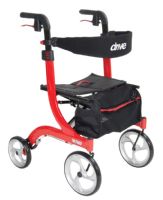 | Drive Nitro Rollator - Drive Medical Euro Style Rollator Walker View Product |
Standard models have two wheels in the front that swivel for steering and two wheels in the back, plus a built-in seat. Distributing the weight over four wheels makes this design very stable. Four-wheeled models are easy to use and don’t require a lot of upper body strength. They can accommodate a wide range of user weights and heights, which makes them the most popular among consumers.
 | 3-Wheel Rollator Walker by Vive Health in Black View Product |
For people who don’t need as much stability as four-wheeled models, three-wheeled rollators have a triangular shape and usually don’t have a seat. They are highly maneuverable, which makes them a great choice for use indoors or more cramped spaces. A tight turn radius makes them easy to control. Being lightweight and foldable, they are convenient to transport and store.
 | Upright Rollator / Rollator Walker with Seat and Forearm Supports View Product |
A forearm rollator is also called an upright rollator. Instead of using low handlebars, the frame of this rollator has armrests that support upper body weight and reduce back and shoulder tension while providing an added sense of stability in an upright position. They also improve gait efficiency.. Shop Upright Rollators to see the features and benefits of th forearm rollators offered by Rehabmart.
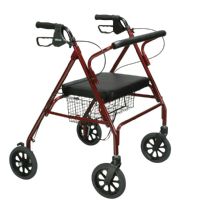 | Drive Medical Go-Lite Bariatric Steel Rollator View Product |
Heavy-duty rollators, otherwise known as bariatric rollators, are built to accommodate larger-framed users. The weight capacity of standard rollators usually ranges between 200 and 350 pounds. Shop Bariatric Rollators to choose from models that have wider seats and can accommodate users weighing up to 700 pounds.
Within the main rollator categories, there are subcategories that take the user’s body type and lifestyle into consideration.
_(1)_(1).jpg&newwidth=365&maxheight=200) | Ultralight Rollator / Carbon Fiber Rolling Walker by Acre View Product |
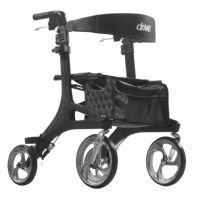 | Drive Medical Nitro Elite Carbon Fiber CF Rollator View Product |
Lightweight rollators are great for people who are “on the go” and have the strength and stamina to support their own body weight. Perfect for people who love to travel, these foldable rollators weigh just a few pounds and are easy to fold and unfold for car or plane travel.
 | Nitro Duet Rollator and Transport Chair by Drive Medical View Product |
For anyone who wants to maintain as much independence as possible, but who still needs assistance from time to time, a dual-purpose rollator and transfer chair allows the users to independently move or sit in the seat while being assisted by a caregiver.
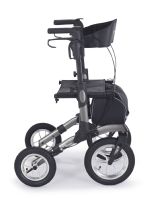 | Comodita Tipo All Terrain Rollator - Portable Rolling Walker with Included Transport Bag View Product |
If you’re adventurous and like to get off the beaten path, shop All-Terrain Rollators for mobility devices suitable for use on all types of surfaces. From pavement to gravel to grass, these rollators have large wheels with great traction and heavy-duty frames to help users enjoy everything from a hike to a day at the golf course.
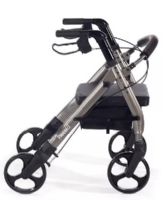 | Petite Rollator Walker with Seat for Users Under 5 ft 5 in - 400lb Weight Capacity - Comodita Piccola View Product |
Shorter users can benefit from hemi-height or petite rollators, providing appropriate support and allowing for proper body mechanics. They are usually lightweight with larger wheels and a high degree of height adjustability.
 | Free2Go Rollator with Built in Commode Seat View Product |
A rollator provides the user with opportunities to get out and explore the world more. This also means there is more of a chance the user will be using a restroom that isn’t their own. A rollator with a built-in commode seat allows the user to approach any toilet, flip the commode seat over the toilet, use the rollator frame for support while lowering on and off the seat, and safely take care of toileting in any restroom. It adds height over a standard toilet to reduce body strain, reducing the risk of a fall.
There are options to further customize a rollator for how and where it will be used most. A well-chosen rollator will enhance safety and support a user’s independence.
 | Nitro DLX Luxury Rollator by Drive Medical View Product |
With a more thickly cushioned seat, appealing styling, and all the standard functional qualities, a luxury rollator doesn’t look like a typical piece of medical equipment that is designed for getting from one place to another. It looks like something to get you from one place to another in style.
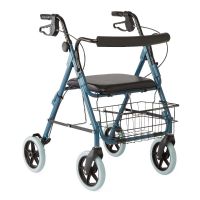 | Guardian Deluxe Rollator with 8 inch Wheels by Medline View Product |
Just as cars and bicycles come in different colors to appeal to different users, rollators also come in a choice of colors. For people who seek support with style when considering their mobility options, choosing an appealing color makes the experience of using one more enjoyable. Anything that will encourage usage for someone who needs a rollator is a benefit.
Navigating a grocery store is easier if the rollator you use has certain features. An generously sized insulated storage bag keeps cold food cold while you are making your way through the store, so you can take your time. A narrow width doesn’t take up too much of the aisle and can fit into tight spaces. This style of rollator is also easy to fold and transport in a trunk or back seat.
 | Stander Lets Go Indoor Lightweight Rollator by Trust Care View Product |
If you’re mainly using a rollator for support while moving around the house, you don’t need a seat to rest on, wheels that can handle uneven terrain, or a lot of storage. A design that isn’t bulky and has a tight turning radius works well for indoor home use. An added bonus with our best Let’s Go Indoor Rollator is a food tray that acts as a built-in mini table.
Ergonomically designed handles contribute to the user’s body working more productively and efficiently while reducing fatigue and discomfort. Ergonomic handles, especially for people with arthritis or compromised grip strength, provide a safe and comfortable grip that make propelling, stopping, and braking easy on the user.
The choice of multiple design features and optional accessories ensures you can find a rollator to fit your needs. The size of the user and size of the rollator, the lifestyle of the user, and where the rollator will be used most are all factors in making the best buying decision.
For anyone who spends time away from home while using a rollator, side bags, baskets, and cup holders provide transport and storage options. Even around the house, though, keeping daily use items conveniently within reach reduces risk of a fall while getting up to retrieve something, and helps create a comfortable environment.
Rollators come with different hand brake designs. Loop-lock brakes are hard plastic hand loops under the handlebars, and they can get tiring for users with diminished hand strength. Single hand brakes are food for users who can only squeeze with one hand. Bicycle brakes act much like loop-lock brakes, but they have a lever to squeeze instead of a loop. Push-down brakes engage when you lean on the handlebars and are good for users with weak hands.
A rollator seat must be measured for correct width. A seat that is not wide enough will jeopardize the comfort and safety of the user. There are special bariatric rollators available in wider widths to accommodate larger-framed users.
Being able to place your feet flat on the ground while sitting on a rollator seat is a key to safety. If your legs dangle or are cramped under you, there is a greater chance for a fall while transferring between sitting and standing. Many rollators feature height adjustability, and there are petite models to safely accommodate users of shorter stature.
A rollator utilized entirely in the confines of a small home doesn’t need the same tires as a rollator used outdoors over asphalt, grass, and gravel. The tire style and size, as well as turning radius, are different for rollators primarily used in a small confined area at home than those that are primarily used while out and about.
The weight of a rollator contributes to its portability. Frames made of aluminum weigh less than those made of steel. A standard weight is about 15 pounds, with lightweight versions specifically focused on portability can weigh as little as 11 pounds.
The weight capacity of a standard rollator is between 200 and 350 pounds. Bariatric rollators are built with heavy duty frames and wider seats. Depending on the model, they can safely accommodate users weighing up to 700 pounds.
Most rollator users appreciate the feature of having a seat to rest on while out walking. Locking casters are important because you must be able to count on the rollator staying in place while you’re seated on it.
Many rollators feature height adjustability. This helps ensure a proper fit, which contributes to the overall safety of the device.
A: A rollator is a good choice for users who need assistance with balance but not with significant weight bearing.
A: Medicare Part B (Medical Insurance) covers rollators as durable medical equipment (DME). It must be medically necessary and prescribed by your doctor or other Medicare-participating treating provider.
A: Rollators cost between $75 and $775.
A: The main difference is a walker is a frame with handles and legs that needs to be lifted for movement, while a rollator has wheels and is pushed
A: We have assembled a list of our top 5 picks, and at the top is the Carbon Fiber Ultralight Rolling Walker by Acre. Super lightweight and easy to maneuver, it folds flat for travel and storage.
A: At 10.6 pounds, the Carbon Fiber Ultralight Rolling Walker is the lightest rollator in the world, and it has a weight capacity of 285 pounds.
A: Since a rollator is not intended to bear weight, it should be used for balance only. If the user can’t support their own body weight, they should not use a rollator. Also, anyone who doesn’t have the hand strength or coordination to operate the hand brakes should not use a rollator.
A: A rollator is used to provide assistance with balance and stability, but not weight bearing. They allow users to walk at a faster pace and maintain a normal gate.
As mobility becomes more challenging for seniors, the world can get progressively smaller. Activity and movement are good for the brain and the body, so a rollator walker can greatly add to the well-being of someone who can no longer safely get around without support for balance and stability.
With so many available models, check out our catalog of Rollators, Bariatric Rollators, and Upright Rollators to help you choose the best rollator for you. Mobility contributes to independence and the ability to accomplish daily living activities, and a rollator is a great tool to support those efforts. Whether you need a seat, extra storage, easy-to-grip hand brakes, or a super lightweight version for maximum portability, there is a rollator walker that will minimize the risk of a fall while facilitating an active lifestyle.
Thank you for reading this article on how to choose the best rollator walker. For more helpful information on how to meet the needs of your loved ones as they age, visit Caregiver University.
>> Shop Rolling Walkers <<
Co-Founder of Rehabmart and an Occupational Therapist since 1993. Mike has spent his professional career working in multiple areas of Occupational Therapy, including pediatrics, geriatrics, hand therapy, ergonomics and inpatient / outpatient rehabilitation. Mike enjoys writing articles that help people solve complex therapeutic problems and make better product choices.